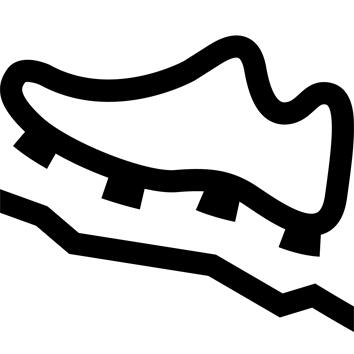HOW OFTEN AND HOW INTENSIVELY SHOULD YOU HIKE?
We have classified our products in terms of performance and functionality to suit 3 levels of mountaineering experience:
- Occasional: around ten hikes a year, lasting 3 to 4 hours, less than 10km and less than 700m ascent.
- Regular: around twenty outings a year. 4 to 6 hours, 10 to 20km, 700 to 1200m ascent per outing.
- Intensive: more than 20 outings per year. More than 6 hours, more than 20 km, 1200 to 2000m ascent per outing.
Sole with grip
The grip of our soles is certified. To qualify, the shoe must pass laboratory tests to evaluate the grip coefficient on different surfaces (smooth, rough, dry, wet). To validate these tests, we have the quality of our soles evaluated in the field, in the mountains, by a panel of representative testers over 500 km.
WHICH SIZE TO CHOOSE?
The most important thing is to try on several sizes and models of shoes to find the one that's right for you!
You can go one size bigger than your usual shoe size to avoid your toes banging against the ground on the way down, as long as your foot is well supported to avoid rubbing.
Tip: keep your nails short and check before any long descent that your lacing is tight enough to prevent your foot from sliding towards the front of the shoe.
Buying advice / How to try on your shoes?
Some Decathlon stores are equipped with a test course.
1. Try on both shoes, standing up, with the socks you use for hiking.
2. Tighten the laces, taking care to distribute the tightening evenly.
3. Check two points:
- the heel does not lift off the front of the shoe when walking uphill.
- the foot does not slip and the toes do not touch the front when walking downhill.
4. Try on several sizes and models.
Use them progressively to make them fit your foot.
Field tests
All our shoes are tested for comfort and use by hikers (external to Décathlon), in conditions identical to those you might find during your hike. The aim is to develop the product, then validate it as objectively as possible to ensure your complete satisfaction.
Laboratory testing
Other laboratory tests are also carried out to validate the following elements: eyelet and strap pull-off, bonding, toxicology, UV resistance, abrasion of sole and upper components, accelerated ageing.
Optimize the performance of your shoes: replace your insoles!
The original insole in your shoes is designed to fit as many feet as possible. A change of insole can provide:
1. Better support: some insoles are preformed or reinforced to better support the arch of the foot.
2. Greater comfort: insoles can also provide warmth and/or cushioning.
3. Longer life: get back the support and comfort of your shoes by replacing the insole every season.
HOW TO AVOID BLISTERS?
Blisters generally appear when our skin is weakened by friction. To reduce the risk of blisters appearing, we advise you to:
- Choose a shoe in your size.
- Wear appropriate socks.
- Tie your shoes properly.
- Don't hesitate to readjust the tightness of your laces during practice, especially before tackling a climb or descent.
- Wear your shoes for a short outing the first time you use them.
How to care for your shoes
- Allow to air dry.
- Remove dried mud with a stiff brush.
- For stains, clean with a brush and lukewarm water
- Allow to dry
- Spray the stem with a waterproofing spray to restore water repellency.


